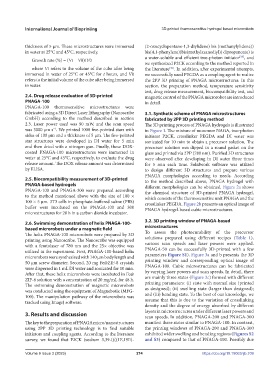Page 282 - IJB-9-3
P. 282
International Journal of Bioprinting 3D-printed thermosensitive hydrogel based microrobots
thickness of 5 μm. These microstructures were immersed (2-oxocyclopentane-1,3-diylidene) bis (methanylylidene))
in water at 25°C and 45°C, respectively. bis(4,1-phenylene))bis(methylazanediyl)) dipropanoate) is
[38]
Growth rate (%) = (Vt - V0)/V0 a water-soluble and efficient two-photon initiator , and
we synthesized P2CK according to the method reported in
where Vt refers to the volume of the cube after being the literature . In addition, after experimental attempts,
[39]
immersed in water of 25°C or 45°C for t hours, and V0 we successfully used PEGDA as a coupling agent to realize
refers to the initial volume of the cube after being immersed the 2PP 3D printing of PNAGA microstructures. In this
in water. section, the preparation method, temperature sensitivity
test, drug release measurement, biocompatibility test, and
2.4. Drug release evaluation of 3D-printed magnetic control of the PNAGA microrobot are introduced
PNAGA-100 in detail.
PNAGA-100 thermosensitive microstructures were
fabricated using a 3D Direct Laser lithography (Nanoscribe 3.1. Synthetic scheme of PNAGA microstructures
GmbH) according to the method described in section fabricated by 2PP 3D printing method
2.3. Laser power used was 90 mW, and the scan speed The 3D printing process of PNAGA hydrogels is illustrated
was 3000 μm s . We printed 1000 five-pointed stars with in Figure 1. The mixture of monomer NAGA, two-photon
−1
sides of 100 μm and a thickness of 5 μm. The five-pointed initiator P2CK, crosslinker PEGDA and DI water was
star structures were developed in DI water for 5 min sonicated for 10 min to obtain a precursor solution. The
and then dried with a nitrogen gun. Finally, these DOX- precursor solution was dipped in a round gasket on the
coated PNAGA-100 microstructures were immersed in glass and printed via 2PP (780 nm). Purified 3D structures
water at 25°C and 45°C, respectively, to evaluate the drug were observed after developing in DI water three times
release amount. The DOX release amount was determined for 5 min each time. Solidwork software was utilized
by ELISA. to design different 3D structures and prepare various
PNAGA morphologies according to needs. According
2.5. Biocompatibility measurement of 3D-printed to the method described above, PNAGA hydrogel with
PNAGA-based hydrogels different morphologies can be obtained. Figure 2a shows
PNAGA-100 and PNAGA-300 were prepared according the chemical structure of 3D-printed PNAGA hydrogel,
to the method mentioned above with the size of 100 × which consists of the thermosensitive unit PNAGA and the
100 × 5 μm. 3T3 cells in phosphate-buffered saline (PBS) crosslinker PEGDA. Figure 2b presents an optical image of
buffer were incubated on the PNAGA-100 and 300 PNAGA hydrogel-based cubic microstructures.
microstructures for 20 h in a carbon dioxide incubator.
2.6. Swimming demonstration of helix PNAGA-100- 3.2. 3D printing window of PNAGA-based
based microrobots under a magnetic field microstructures
The helix PNAGA-100 microrobots were prepared by 3D To assess the photocurability of the precursor
printing using Nanoscribe. The Nanoscribe was equipped solutions prepared using different recipes (Table 1),
with a femtolaser of 780 nm and the 25× objective was various scan speeds and laser powers were applied.
utilized in the experiment. First, PNAGA-100-based helix PNAGA-50 can be successfully 3D-printed with a few
microrobots were synthesized with 140 μm body length and parameters Figure S1). Figure 3a and b presents the 3D
50 μm screw diameter. Second, 20 mg Fe@ZIF-8 crystals printing window and corresponding optical image of
were dispersed in 1 mL DI water and sonicated for 10 min. PNAGA-100. Cubic microstructures can be fabricated
After that, these helix microrobots were incubated in Fe@ by varying laser powers and scan speeds. In detail, there
ZIF-8 solution with a concentration of 20 mg/mL for 48 h. are mainly three states (Figure 3c) formed with different
The swimming demonstration of magnetic microrobots printing parameters: (i) state with normal size (printed
was conducted using the equipment of Magnebotix (MFG- as designed); (ii) swelling state (larger than designed);
100). The manipulation pathway of the microrobots was and (iii) bending state. To the best of our knowledge, we
tracked using ImageJ software. assume that this is due to the variation of crosslinking
density and the degree of energy absorbed by different
3. Results and discussion layers in microstructures under different laser powers and
scan speeds. In addition, PNAGA-200 and PNAGA-300
The key to the preparation of PNAGA micro/nanostructures manifest three states similar to PNAGA-100. In contrast,
using 2PP 3D printing technology is to find suitable the printing windows of PNAGA-200 and PNAGA-300
initiators and coupling agents. According to the literature exhibited wider swelling and bending regions (Figures S2
survey, we found that P2CK (sodium 3,39-((((1E,19E)- and S3) compared to that of PNAGA-100. Possibly due
Volume 9 Issue 3 (2023) 274 https://doi.org/10.18063/ijb.709

